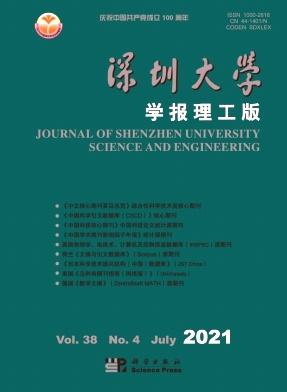Bioactive secondary metabolites from two sponge-derived actinomycetes
Q4 Engineering
Shenzhen Daxue Xuebao (Ligong Ban)/Journal of Shenzhen University Science and Engineering
Pub Date : 2022-09-01
DOI:10.3724/sp.j.1249.2022.05550
引用次数: 1
Abstract
Actinomycetes residing in marine habitat are an excellent treasure house of structurally novel and Received: 2022-01-10; Accepted: 2022-06-06; Online (CNKI): 2022-08-09 Foundation: Hainan Provincial Basic and Applied Basic Research Fund for High-Level Talents in Natural Science (2019RC306, 2019RC352); Central Public-Interest Scientific Institution Basal Research Fund for CATAS-ITBB (1630052022028, 1630052022016, 1630052019011); Financial Fund of the Ministry of Agriculture and Rural Affairs of China (NFZX2021) Corresponding author: Associate professor GUO Zhikai. E-mail: guozhikai@itbb.org.cn Associate professor LI Ming. E-mail: liming0898@163.com Citation: GUO Zhikai, WANG Rong, WU Weicheng, et al. Bioactive secondary metabolites from two sponge-derived actinomycetes [J]. Journal of Shenzhen University Science and Engineering, 2022, 39(5): 550-558. (in Chinese) 第 5期 郭志凯,等:两株海绵放线菌产生的抗菌活性产物研究 http://journal.szu.edu.cn bioactive natural products with potent medicinal values. To exploit chemically diverse and bioactive natural products from actinomycetes living in underexplored ecological niche, we isolate a large number of marine actinomycetes from marine sponges, corals, algae, mollusks, sea grasses, and sediments collected from the South China Sea. In order to assess the values of these special marine actinomycetes in the green development of tropical agriculture, we screen the activity of marine actinomycetes against phytopathogenic fungi and bacteria. As a result, we identify two strains of sponge-derived actinobacteria Streptomyces sp. HMH1 and HML1 possessing antagonism effect against tested phytopathogenic microbes. The secondary metabolites produced by these two actinomycete strains and their antiphytopathogenic fungi activity are investigated. The secondary metabolites from the fermentation extract of Streptomyces sp. HMH1 and HML1 are isolated and purified using various chromatography methods including silica gel column, reverse gel column and Sephadex LH-20 column chromatography. The structures of the isolated compounds are characterized by NMR, HR-ESI-MS spectroscopic data analyses and comparison with previously reported data. Three major compounds belonging to the family of actinomycin are purified from the solid fermentation extract of the sponge-derived actinobacterium Streptomyces sp. HMH1. They actinomycin D, actinomycin X2, and actinomycin Xoβ. A compound identified as K-252d belonging to the family of indolocarbazole alkaloid is isolated from the solid fermentation extract of another sponge-derived actinobacterium Streptomyces sp. HML1. The antiphytopathogenic fungi and bacteria activities of these compounds are evaluated against ten species of plant pathogenic fungi including Fusarium oxysporum FOC4, Lasiodiplodia theobromae, Phomopsis caricae-papayae Fetrak&Cif., Corynespora cassiicola, Phytophthora capsica, Pythium aphanidermatum (Edson) Fitzp, Corynespora sp., Fusarium graminearum, Verticillium dahlia, Pestalotiopsis microspora, and two species of plant pathogenic bacteria including Xanthomonas oryzae pv. oryzae and Ralstonia solanacearum. The bioactivity test results of the compound against agricultural pathogens show that actinomycin D possesses inhibitory activity against the growth of these tested phytopathogenic fungi and bacteria. among which, actinomycin D has the most potent inhibitory activity against the plant pathogenic fungi Lasiodiplodia theobromae, Phomopsis caricae-papayae Fetrak&Cif., Fusarium graminearum and Phytophthora capsica, with inhibitory rate of (60.09 ± 0.66)%, (48.82 ± 0.66)%, (46.47 ± 1.14)% and (44.13 ± 0.66)% , respectively. In addition, actinomycin D displays strong antibacterial activity on the plant pathogenic bacteria Xanthomonas oryzae pv. oryzae and Ralstonia solanacearum with bacteriostatic diameter at (36.00 ± 0.82) mm and (15.00 ± 0.47) mm, respectively. These results provide new compounds and bacteria resources for the development of high-efficiency biocontrol agents for agricultural disease control.两种海绵来源放线菌的生物活性次级代谢产物
生活在海洋栖息地的放线菌是结构新颖的优秀宝库,收到时间:2022-01-10;受理日期:2022-06-06;在线(CNKI):2022-08-09基金资助:海南省自然科学高层次人才基础与应用基础研究基金(2019RC3062019RC352);中央公益性科研机构基础研究基金项目(16300520282016300520220161630052019011);中国农业农村部财政资金项目(NFZX2021)通讯作者:郭志凯副教授。电子邮件:guozhikai@itbb.org.cn李明副教授。电子邮件:liming0898@163.com引文:郭志凯,王荣,吴伟成,等。两种海绵状放线菌的生物活性次级代谢产物[J]。深圳大学学报,2022,39(5):550-558。(中文)第 5.期 郭志凯,等:两株海绵放线菌产生的抗菌活性产物研究 http://journal.szu.edu.cn具有强大药用价值的生物活性天然产品。为了从生活在未充分开发的生态位中的放线菌中开发化学多样性和生物活性的天然产物,我们从南海的海绵、珊瑚、藻类、软体动物、海草和沉积物中分离出大量的海洋放线菌。为了评估这些特殊的海洋放线菌在热带农业绿色发展中的价值,我们筛选了海洋放线杆菌对植物病原真菌和细菌的活性。结果,我们鉴定了两株海绵来源的放线菌链霉菌。HMH1和HML1对测试的植物病原微生物具有拮抗作用。研究了这两株放线菌产生的次生代谢产物及其抗真菌致病活性。利用硅胶柱、反相凝胶柱和Sephadex LH-20柱等多种色谱方法,分离纯化了链霉菌发酵提取物中的次生代谢产物HMH1和HML1。通过NMR、HR-ESI-MS光谱数据分析以及与先前报道的数据的比较来表征分离的化合物的结构。从海绵衍生的放线菌链霉菌HMH1的固体发酵提取物中纯化了属于放线菌素家族的三种主要化合物。它们是放线菌素D、放线菌素X2和放线菌毒素Xoβ。从另一种海绵衍生的放线菌链霉菌HML1的固体发酵提取物中分离出一种属于吲哚咔唑生物碱家族的化合物K-252d。评价了这些化合物对10种植物病原真菌的抗植物病原真菌和细菌活性,这些真菌包括尖孢镰刀菌FOC4、席溴Lasiodiplodia、辣椒Phomopsis caricae papayae Fetrak和Cif。,肉桂棒孢菌、辣椒疫霉、无叶腐霉(Edson)Fitzp、棒孢菌属、禾谷镰刀菌、大丽花轮枝菌、微孢子虫和包括水稻黄单胞菌在内的两种植物病原菌。米曲霉和青枯菌。该化合物对农业病原菌的生物活性测试结果表明,放线菌素D对这些被测植物病原真菌和细菌的生长具有抑制活性。其中放线菌素D对植物病原真菌木犀(Lasiodiplodia theobromae)、罂粟(Phomopsis caricae papayae Fetrak&Cif)具有最强的抑制活性。,禾谷镰刀菌(Fusarium graminearum)和辣椒疫霉(Phytophthora capsica)的抑制率分别为(60.09±0.66)%、(48.82±0.66。此外,放线菌素D对植物病原菌米黄单胞菌pv表现出较强的抗菌活性。其抑菌直径分别为(36.00±0.82)mm和(15.00±0.47)mm。这些结果为开发用于农业疾病控制的高效生物防治剂提供了新的化合物和细菌资源。
本文章由计算机程序翻译,如有差异,请以英文原文为准。
求助全文
约1分钟内获得全文
求助全文
来源期刊

Shenzhen Daxue Xuebao (Ligong Ban)/Journal of Shenzhen University Science and Engineering
Engineering-Engineering (miscellaneous)
CiteScore
0.90
自引率
0.00%
发文量
14
 求助内容:
求助内容: 应助结果提醒方式:
应助结果提醒方式:


